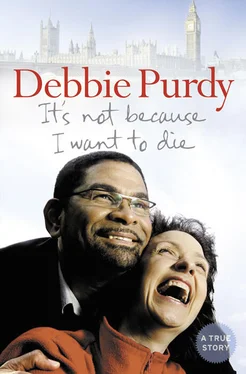So that was it! Depression wasn’t as sexy as a brain tumour, so I was a bit disappointed. I still clung to my ‘heroic Debbie’ image. I’d never been the depressive type and I wasn’t sure I believed his diagnosis, but doctors are always right, aren’t they?
I went down to stay with my uncle Paul in Brighton before my flight back to Singapore. As it happened, his friend’s son had had a brain tumour and they urged me to get a second opinion. They just had an instinct that my doctor’s diagnosis wasn’t quite right.
I went to see my uncle’s GP, a smart, no-nonsense woman with a surgery in Brighton. After listening to my description of the symptoms, she got me to lie down and drag my heel up my shin – first the left heel, then the right. I managed it, but there must have been something she didn’t like about the way I did it. She ran a few more tests and asked me lots of questions, then said she was going to refer me to a neurologist.
Good, I thought. A neurologist sounded serious and important. Surely he would be able to send me for a brain scan and we’d be a little closer to coming up with a diagnosis, something unusual and interesting.
I was warned it would be a couple of months before the appointment came through, so I went back out to Singapore, still secretly convinced I had a brain tumour. I didn’t tell Mildred or anyone else about my theory because it sounded melodramatic. In answer to their questions I said, ‘Oh, there’s nothing wrong with me,’ imagining that when I finally told them the truth they would think, Poor thing, she was trying to be brave and play it down when all along she was suffering terribly.
Peter, my boss at the adventure travel company, seemed to be happy with my work because he asked if I would like to go on a scuba-diving course on Tioman Island, off the Malaysian coast. Would I ever! The idea was that I would write a diary of my experiences that would be published by 8 Days, a magazine about what’s on in Singapore. Peter, his partner and other colleagues could already dive and they wanted someone who could write about the learning experience. Once I could dive, Peter promised that he would send me to review other scuba sites they covered.
I loved the resort on Tioman, a genuine paradise island with white sand and palm trees. The staff were bottle-feeding a little orphan monkey whose mother had been killed by poachers and everyone liked playing with him because he was so cute and cuddly.
I found the underwater world magical. If you learn to dive off the British coast, the visibility is likely to be measured in inches, feet if you’re lucky, but in the South China Sea we could see way off. It was incredible to be underwater marvelling at the rainbow-coloured fish and strange tentacled creatures, and my worries about a brain tumour faded into the distance. How could I possibly be ill when I felt so alive and exhilarated?
Back in Singapore, reality intruded when I got word that my neurology appointment would be on 6 March and the therapy session a couple of weeks later. It was time to make another trip to the UK, just after I’d started going out with Omar.
‘You won’t send anyone else on the diving trips, will you?’ I asked Peter. ‘You’ll definitely wait for me to come back?’ I think I’d have cancelled the appointments otherwise.
‘It will all be here waiting for you,’ he promised. ‘Good luck!’
On 6 March 1995 I turned up for my neurology appointment at the Royal Sussex County Hospital. I recited the list of symptoms, mentioned that my parents had died recently and ventured my humble opinion that I might have a brain tumour.
‘Lie down on the bed,’ the neurologist instructed. ‘Tell me what you can feel.’
I could see he was holding a pin, and as far as I was concerned he just touched it lightly on my foot, pressing a bit harder as he moved up my leg, then stabbing it into my thigh. That’s what I told him.
‘Actually, I applied the same pressure all the way up,’ he told me.
I blinked in surprise. It seemed I had reduced sensation in the lower parts of my legs. What on earth did that mean?
‘I’m sending you for an MRI scan,’ he said. ‘We’ll talk after that.’
I went back to my auntie Pat and uncle Dennis’s house where I was staying, puzzled by the fragments of information I’d gleaned. Why would a brain tumour cause reduced sensation in my lower legs? Was that why I’d been feeling weird when I was dancing, and why I’d collapsed in the street that day with Greg?
I’d heard it took months for MRI appointments to come through, but mine only took about ten days. Why was it so fast? Was it due to mega-efficiency on the part of the hospital, just good luck, or had the neurologist told them it was urgent?
‘It will take about forty-five minutes,’ the radiographer told me. ‘You have to lie very still on a bed that will slide inside a hollow tube, where we will take pictures of your insides a bit like a 3D X-ray. It’s a bit noisy in there, so you’ll need to wear some earplugs.’
I lay down on the bed, earplugs in place and a call button in my hand in case I got a sudden attack of claustrophobia. I was swept into the machine. There was a moment of silence, then a cacophony of clanking and long piercing beeps and a churning, whirring sound. After only a few minutes the noise stopped and I was sliding out again.
‘What’s up? You said it would take longer.’
‘I’ve got all I need,’ the radiographer told me.
‘You’ve found something, haven’t you? Is it a brain tumour?’
‘The consultant will study the images and discuss the results with you. He has to interpret them.’
I knew they had found something. They must have. Why else had it only taken a few minutes? But they wouldn’t tell me.
I was due to travel up to Yorkshire the next day to see the therapist I’d been referred to, but I rang my neurologist first.
‘Should I go to Yorkshire?’ I asked, and explained the situation.
‘No, come in to see me tomorrow morning at ten to nine, before surgery starts.’
That’s when I knew for sure that they’d found something. I spent the night imagining the worst and trying to talk myself round. My aunt and uncle drove me to the hospital the next morning and at my request they waited outside in the car park. I wanted to face this on my own.
‘So what is it?’ I asked as I sat down, more nervous than I was when I sat my O levels – and that’s saying something.
The consultant looked grave. ‘When I first saw you, I thought you had MS.’
I waited for the other shoe to drop.
‘And it is MS.’
It’s normally hard to shut me up, but I couldn’t think of a single thing to say. The consultant continued that he was going to refer me for a lumbar puncture so that he could definitely rule out a couple of other things, but said he was convinced it was multiple sclerosis. He had been pretty sure from my gait when I first walked into his office, and the MRI scan had backed up his instinct. We made an appointment to talk again after I’d had the lumbar puncture.
I left his office and walked back down to the car park, where my aunt and uncle were waiting, and still I couldn’t speak. I got into the car and stared at them wordlessly with an overwhelming sense that my life had just changed for ever.
Then I rejected it. He had to be wrong. Please, God, he simply had to be.
Chapter 3 ‘Can I Scuba-Dive?’
The only thing I knew about multiple sclerosis was that it was not a good illness to have. All I could think of was a poster I’d seen of a girl with her spine torn out and the legend ‘She wishes she could walk away from this picture too.’ Did that mean I wouldn’t be able to walk any more? That’s when I began to get upset. I couldn’t bear it if I ended up in a wheelchair.
Читать дальше












